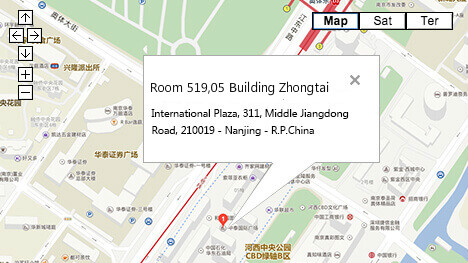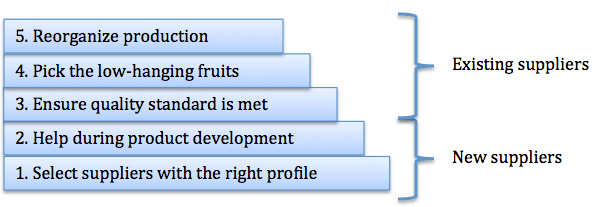Pins recall alert published by the United States Consumer Product Safety Commission ( CPSC) and…
Sourcing from China: The 5 Steps to Developing a Chinese Supplier
BY RENAUD ANJORAN
Many importers work in one or two product categories. They buy 80% of their volume from 1-4 manufacturers.
And many of them make the same mistake: they don’t try to improve their CURRENT suppliers. Instead, they spend time sourcing NEW factories and training them to their requirements, and consequently they are taking risks on the first order from a new supplier.
Is there an alternative? Sure.
A supplier development program follows 5 steps. And it starts at the sourcing phase!
1. Selecting suppliers with the right profile
This is all about finding suppliers that want to improve, however, if you work with companies that are NOT trying to improve, the upside will be quite limited.
A large customer can push a factory to make improvements, but it’s quite hard (sometimes impossible) if that factory’s boss doesn’t care about getting better. Many of these bosses are only interested in getting bigger, by using their current operations and practices.
How to spot potential suppliers that are motivated to get better? Here are a few examples.
- They re-invest profits in the facilities, the equipment, staff training, and so on;
- They want to develop new products/technologies, and are willing to go through a steep learning curve;
- They hire professional managers rather than members of the owner’s extended family.
2. Help during product development
This step is important if you purchase highly customized products.
The buyer needs to take the following actions:
- Explain the product’s specifications clearly;
- Translate what these specs mean, from a technical point of view (at the production process level);
- Train their QC staff to check the specs during production and on finished products, and help set testing stations (this critical step is often forgotten);
- Give detailed feedback on pre-production samples/prototypes.
For complex products, spending time in the factory and communicating directly (in Chinese) with the technicians is a big plus.
3. Ensure your quality standard is met
As your first orders move into production, the focus should be on quality. If production quality is not acceptable on your market, and if there is no improvement over time, there is no way to continue the relationship.
The question is; how do you get a supplier to improve its quality, without spending a fortune on inspection in order to catch all their mistakes?
You need to audit their quality system and their processes, and then evaluate what the priorities are. Here are a few examples:
- The managers never get out of their offices, and don’t monitor discipline on the shop floor.
- Incoming components & materials are not checked, or nobody knows when they should be rejected.
- There are no procedures or procedures are insufficient/unclear for in-process inspections.
- Work instructions for operators and inspectors are not accurate, poorly designed, or not respected.
- Nobody has collected data about the most frequent defects and wondered what their root causes are in a systematic way.
The best policy for those buyers who purchase large quantities from one supplier, is to send an engineer to the factory on a regular basis (once a month), to discuss and show the supplier potential opportunities for improvement and identify where processes could be made clearer or better (don’t call it “audits”), I detailed how it works in this article.
Once a manufacturer has a strong system in place and inspires enough confidence, they can be allowed to “self-inspect” and to report their findings to the buyer.
4. Pick the low-hanging fruits
To an experienced industrial engineer, the typical Chinese factory is full of opportunities for improvement. A lot of small changes can be made to cut costs, without investing in any new equipment or breaking any walls.
By applying a gentle mix of pulling and pushing, you can probably help some of your key suppliers grasp some of these obvious opportunities.
For example, some importers ask key suppliers for a roadmap to reduce their cost structure in the coming years (with details on how they intend to achieve these targets). This is an excellent exercise to push suppliers to think of how to work smarter, and to run some tests.
Some other buyers know production processes better than most manufacturers they work with, and help them reduce their “costs of poor quality” (scrapped material, defects to rework, chargebacks from customers…).
Good communication and frequent visits are key if you want this effort to be successful.
5. Re-organize production
Step No.4 focused on the “easy wins” that require little effort and bring obvious gains.
Once you have accumulated enough of these easy wins and the factory’s management starts to trust you, it is time to become more ambitious.
Here is the sequence I advise you to follow:
- Select one priority — here are 3 examples: quality, cost, faster production cycle and smaller batches;
- Select 2-4 KPIs, and track their improvement over time;
- Pick targets for the KPIs, and envision the “future state” that needs to be achieved to meet these targets;
- Discuss it with the factory and get their agreement and buy in;
- Make changes to reach that future state, if possible by starting with a “quick win” that everybody can see;
- Start over again with a new target, after the team got a sense of victory and has energy to take on another challenge.
In the next two parts in this series, I will explain how “Lean”, a set of principles and techniques inspired by the Toyota Production System, can help you drive impressive results in quality improvement and in cost reduction.
Article Source: https://qualityinspection.org/inspectors-fail-china/



This Post Has 0 Comments